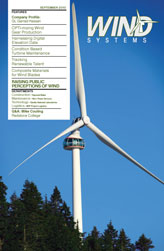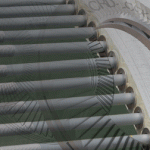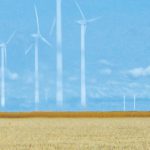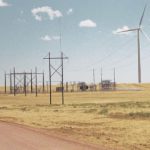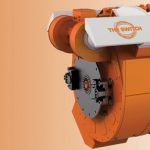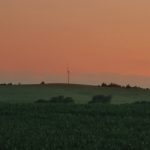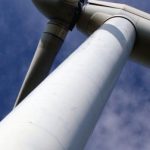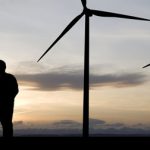From determining optimum wind conditions in a large general region to micrositing turbines in more localized areas, the proper location of wind power facilities is imperative. Precise elevation data can be used to develop viewshed analysis, project siting plans, visualization and preconstruction presentations, and other critical aspects of wind power project planning. In short, high-resolution elevation data can improve many physical and environmental suitability aspects of wind power analysis, all while helping to control a project’s final cost.
Data Quality and Cost
Elevation data can be gathered from a variety of optical and microwave sensor sources, each with its own set of benefits and drawbacks. For instance, the lowest-cost (or even freely distributed) elevation data has been gathered by satellites. However, most satellite-sourced elevation data has vertical accuracy ranging from 3 to 10 meters. Shuttle Radar Topography Mission (SRTM) elevation data, collected onboard the U.S. space shuttle Endeavour in 1990, provides coverage for much of the world at 10- to 15-meter vertical accuracy. At the other end of the precision spectrum is data collected with Light Detection and Ranging (LiDAR) technology, which offers 20-centimeter vertical accuracy, and at a much higher price than other options. Aircraft-mounted interferometric synthetic aperture radar (IFSAR) data, which has an average vertical accuracy of 1 meter, lies in the middle of that precision and pricing range. Figure 1
Each digital elevation dataset has a different posting, or the size of the grid on which individual elevation measurements are taken. For instance, a RADARSAT-derived elevation dataset has a 30-meter posting, meaning that elevation values are available every 30 meters in the dataset, with vertical elevation values accurate within 10 meters. Intermap Technologies’ IFSAR-derived NEXTMap dataset has a 5-meter posting specification with a predominantly consistent 1-meter or better vertical accuracy.
The range in vertical accuracy and posting specifications of digital elevation data lends itself to the different types of applications in the wind energy market. Reconnaissance mapping, for example, is generally conducted on a 1:50,000 scale and thus requires a less-accurate dataset, whereas micrositing a series of turbines would require significantly more precision since a turbine in a location with prime wind conditions can be almost twice as productive as another located only 30 meters away, the horizontal and vertical accuracy of data used in the micrositing process is critical.
Intermap’s NEXTMap USA and NEXTMap Europe datasets provide complete uniform coverage of the contiguous United States and Hawaii, as well as all of Western Europe, respectively. NEXTMap Europe was made commercially available in May 2009, and NEXTMap USA was made fully available in June 2010. The programs mark the first time in history that a private company has remapped, processed, and edited digital elevation data for the United States and Western Europe.
Elevation Data Crucial
Digital elevation data provides information for planning new infrastructure, assists in the prediction of wind condition calculations, and can help project planners make more cost-efficient business decisions about existing infrastructure and accessibility. Wind project planners know that it’s important to identify the various factors that can affect a project’s cost structure, such as:
• Local policies, including restrictions that govern turbine height, noise levels, and protected environmental areas;
• Product standards and certifications required by local authorities;
• The potential of extreme weather and natural disasters;
• The planned site’s infrastructure and accessibility.
High-resolution digital elevation models (DEMs) and aerial images that have been orthorectified using those DEMs allow planning to proceed based on the exact geospatial locations of existing infrastructure such as access roads and transmission lines, and therefore more accurately predict the cost of extending transmission lines or building new facilities. Because wind farms are predominantly located in rural open areas or on mountainous terrain, far removed from urban centers where the greatest power demand exists, efficiently locating the best placement of the transmission line corridor is critical to a project’s success. Digital elevation and image data provide planners with the ability to take a number of key factors including terrain, land acquisition, and cost into account while optimizing the route of a transmission corridor, all while reducing the costs, time, and risk involved with the project. Figure 2
For instance, an orthorectified radar image (ORI)—a grayscale image of the earth based on a DEM—accentuates topographic features on the earth’s surface far more than what is possible with a standard aerial photograph. An ORI of an existing wind farm allows planners to be aware of the precise location of all current infrastructure including wind turbines, transmission lines, power stations, and highways when considering a possible expansion of the farm.
DEMs Provide Planning Information
Digital elevation models (DEMs)—which include digital surface models (DSMs), digital terrain models (DTMs), and orthorectified radar images—provide a wealth of information about many different aspects of a wind farm development project, and they can help definitively determine whether a proposed site can accommodate wind turbines and supporting infrastructure such as roads and transmission lines. Further, the information can be used to determine the efficiency of turbines in a proposed location compared to those in another location. Figure 3
Both DSMs and DTMs provide critical information including elevation analysis, slope gradients, and ridgeline locations. DSMs present a wide array of accurate, three-dimensional information about potential site locations, including the crucial viewshed analysis. Adherence to local setback regulations, critical to the local approval of any wind farm planning project, can be achieved with the information conveyed by DSMs.
DTMs, derived from DSMs, are topographic models of the bare earth from which vegetation, buildings, and other cultural features have been digitally removed. DTMs are ideal solutions for planning construction of wind power facilities, from micrositing turbines to placing access roads and transmission lines.
DTMs are also used to develop landslide hazard maps for areas with significant slopes such as ridgelines. For instance, DTMs could be used to classify the terrain in a proposed development area into slope grade categories of less than 20 percent, between 20 and 30 percent, and more than 30 percent, and those categories would then be superimposed with local soil survey maps that provide soil type information such as whether the soil is predominantly silt, clay, or bedrock. The resulting map would provide a planner with information about whether a proposed site meets a local government authority’s criteria for landslide hazards. Figure 4
To help minimize contact between birds and wind turbines, DEMs have been used in studies that combined wind velocity and direction, tower height, and bird behavior such as elevation of their flight, among other factors, with the slope, aspect, elevation, and orientation to wind direction of the terrain.
Still in the planning phase, aerial photography is coupled with digital elevation data to produce three-dimensional visualizations, panoramic views, and line-of-sight viewshed perspectives, allowing planners to see the possible impact of a proposed wind farm development. The perspectives allow planners to realistically see what a proposed wind farm would look like from a particular point on the ground, or to accurately determine how much, if any, of a wind farm could be seen from a particular point.
For instance, a viewshed perspective can show exactly how many turbines would be visible from a farmer’s house. Using only an aerial photograph of the house and surrounding terrain, it’s difficult to determine the extent to which a series of turbines could be seen from the house. Using digital elevation data together with the aerial photograph, a viewshed perspective will illustrate exactly which, if any, of the turbines can be seen from that house. Viewshed perspectives can be developed with varying factors, such as the radius of the viewshed; a three- or five-mile radius from the farmhouse, for instance.
To help demonstrate the visual effect of a planned wind farm, ORIs provide up to date and accurate information that helps interested parties see the potential impact of a project in relation to existing infrastructure, and to a precision that’s unavailable with standard aerial images. Because ORIs are generally derived from DEMs, their horizontal accuracy is dependent on the accuracy of the original digital elevation model. An Intermap ORI derived from a NEXTMap DEM, for instance, has a 1.25-meter pixel resolution—each pixel in the image covers 1.25 meters, or about 49 inches, on the ground—and an average horizontal accuracy of 2 meters. Since they are images rather than digital elevation data, ORIs have no vertical accuracy specification.
Terrain Analysis and Wind Modeling
The software packages that extrapolate wind climate statistics and create wind flow models—information used to predict wind farm production and efficiency, calculate power production, and microsite turbines—use terrain data as one of their primary inputs. In the case of wind modeling the “roughness,” or level of terrain detail, of the elevation data used is critical in order to accurately predict wind currents. Forest canopy height data from Intermap’s NEXTMap program was recently used in a study conducted by Meteodyn to show the effects of high-level disturbances and strong wind shears in forested areas. DTMs are also used to create contour lines. Together with the land use digital map and meteorological data, contour lines can help determine the potential wind energy that could be obtained at a particular site.
On a regional level, digital elevation data and orthorectified images can help a wind project planner determine the optimum areas in a very large region in order to further refine the search for a project site. By combining various factors such as terrain elevation, slope, land use, access to existing infrastructure and the power grid, federally and locally protected areas, and models of wind power potential provided by software, a planner can localize a search to only those areas that meet each of the optimum conditions. For instance, a planner can restrict site searches to only those areas that are at a certain vertical elevation and within a certain number of miles of the power grid, while excluding those areas that are a certain number of miles within any airports, national parks, urban areas, and many other variables. This approach, generally undertaken with a geographic information system (GIS), saves considerable time and resources while reducing unnecessary risks and costs.
The wind energy applications enabled by digital elevation datasets are wide and varied, and as the industry continues to grow the list of uses for precision elevation datasets will undoubtedly expand as well.



















